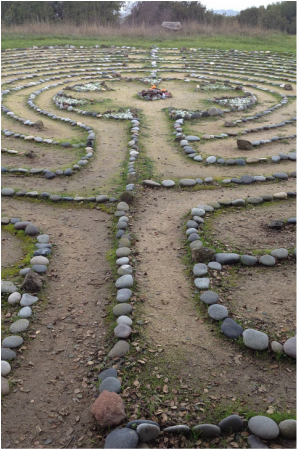 Life is a journey. I have been keenly aware of that for a good portion of my life. I guess I became aware of the power of the metaphor in my early twenties when I broke away from some cultural patterns that diverted me from what a friend called “the franchised life” — that more or less predictable and predefined path for a Mexican woman, or for anyone who doesn’t question their status quo. This summer I was for three weeks in Europe: two weeks working in Germany with The Journey Network and then one week in Patmos, Greece, co-learning with my dear friends of Good World Journeys. Without a complete ability to express what has changed, I can feel in my being that the experience was deeply transformative and I’m in a different place. Yes, it was a journey. My mentor Bela H. Banathy used the metaphor of “the journey" to talk about evolutionary learning and design. His book Systems Design of Education has the subtitle: A journey to create the future. This is the book that helped me discover my passion for systemic change and innovation in education. This is the book that helped me clarify that I needed to do my Ph.D. and that I wanted to study with him. In a way, this book was my ticket for the next stage of my learning journey. I talked of the power of evolutionary learning in my previous blog. Bela’s social systems design methodology involved “transcendence” – a leap into the possible future – rather than incremental change. The process of transcendence was essential: the difference that made the difference when compared to other strategic thinking processes. It is through transcending the existing system that we can envision a different future, an ideal to guide us, to pull us beyond problem solving and to inform the innovation of new, ethical social systems. Rather than focusing our energy on understanding what’s wrong with our current situation and trying to fix it, we invest our efforts in designing and experimenting with new possibilities. Systems design is not a mechanical step-by-step process. Not at all. My way of describing it is more akin to creating the conditions for the emergence of the new system. Bela defined social systems design as a “future creating disciplined inquiry” in the same spirit of Buckminster Fuller’s idea that: “You never change things by fighting the existing reality. To change something, build a new model that makes the existing model obsolete.” Systems design is also the evolutionary pattern captured in Otto Scharmer’s Theory U process – without the deepening at the bottom of the U, we are doomed to improve on existing patterns rather than sensing and allowing what wants and needs to emerge. Transcendence is a way of describing the evolutionary transition from one stage to another. Evolution is a journey towards greater complexity, and complexity involves greater interconnectivity. And yet, that increase in structural complexity doesn’t necessary involve more complicatedness but it can bring greater functional simplicity. Think of the evolution of technology: a computer used to be this clunky big machine that took up a whole room and required special temperatures and a full team of highly specialized humans to operate it, and now we have handheld devices with greater computing capacity that even a toddler can figure out. In my own words, complexity is graceful: greater efficiency and elegance, greater reciprocity and resilience, greater capacity for creativity and emergence. The more complex a system, the more beauty and mystery and awe we experience. Evolution is a quest towards more integration, increased dynamic harmony, and wholeness. Biologist Elizabeth Sahtouris says that “the evolutionary process is an awesome improvisational dance that weaves individual, communal, ecosystemic and planetary interests into a harmonious whole.” The most important aspect of this evolutionary pattern is its non-linear nature. It is a stochastic process, a dance with rhythm consisting of periods of dynamic stability (homeostasis) followed by transitions of rapid chaotic change. It is this chaotic period where the system reconfigures itself, and leaps or transcends to a higher, more complex form of organization. Uncertainty and ambiguity are characteristics of the transitions. The system that emerges from this reconfiguration is consistent and coherent with the previous organizational stage, and yet, it’s final form could have not been predicted or controlled during the transition. Bela used to tell the Native American story of Jumping Mouse to explain the process of transcendence. Jumping mouse is an archetypal story of the hero's journey, a story of personal evolution and an allegory to describe the process experienced by a community engaged in systems design. I have always loved the story as a reminder that life is a journey of becoming more fully who we are meant to become. This inquiry about transcendence in systems design has been appealing and intriguing to me. There is something both in the scientific description and in the indigenous story of the pattern of an evolutionary journey that feels like a deeper truth. I recognize it in my own experience. Bela was passionate about education and human development. In his own personal story, he talked about the seven stages of his life, and in addition to the emphasis on transcendence at the group and cultural level, he recognized the importance of the evolution of consciousness as prerequisite for envisioning a new society. What I didn’t get from Bela (due to my own developmental stage at the time) was the insights related to the emotional and psychological aspects of transcendence. I didn’t know how transcendence “felt” and how it looked in our personal lives. I made that connection through my own personal experiences, through going through the dark night of my soul, and as part of my desire and commitment to (re)connect my work to healing and indigenous knowledge. Transcendence, in many indigenous cultures, is facilitated through ceremony, initiation rituals, or rites of passage. The metamorphosis from caterpillar to butterfly has become a cliché for describing transformational processes. I have always wondered if the caterpillar experiences fear of the unknown as she goes into the cocoon. I did. Inside the cocoon, all the cells of what used to be the body of the caterpillar become a mush while the imaginal cells – the cells that will become the butterfly – arise faster than the old immune system can fight, feeding from the soupy meltdown of what used to be the caterpillar’s body: the deep reconfiguration of the transcendence stage. What I didn’t know, and found fascinating, is that the only thing that remains intact in this transition is her heart. What a beautiful metaphor. Listening to our heart as the source of the deeper truth that connects our past and future self is the way to navigate the chaos and confusion of transcendence. Who am I, really? Who are my people? Where do I belong? Why am I alive? These questions are at the core of the human experience. The search for purpose, meaning and connection is as strong as the impulse of our heart to beat and keep us alive. When we don’t find answers to these questions, or when we are not encouraged and supported to even ask them, we disconnect — from ourselves, each other, life. I grew up in a family and social context that provided a lot of emotional and psychological safety around these questions: cultural norms and religious beliefs were there as answers. In my teens, I didn’t feel the need to question those answers. On the one hand, I can see the beauty of being held in the certainty of moral beliefs. On the other, those beliefs are the ones that keep us trapped in patterns that sometimes prevent the honoring of a deeper truth and the evolution of a culture. The role of tradition and religion in providing some of these answers connected to our sense of purpose and belonging is deteriorating. The current planetary crisis calls for a bigger, all encompassing, rite of passage from unconscious to conscious humanity, from irresponsible adolescence to responsible adulthood as a species. Our global civilization is not based on spiritual wisdom, but rather has become an out-of-control race to find “happiness” through the consumption of material goods and egotistical gratifications. Rituals to help us become useful and honorable members of our community and to be welcomed into adulthood used to be a core experience in our distant evolutionary human history, but not anymore. Are these practices relevant today? The metaphor of the journey, the response to the invitation to embark in an evolutionary learning process of self-discovery and self-creation, is helpful when I think of what is missing in the current educational model. It is a call to transcend our (self-imposed or cultural) limitations, to go beyond the status quo of our lives, to make sense of what is going on in the world and to find our place in it. It is the quest to find that overlap between what brings joy and meaning to our life while we contribute our gifts to the healing of the world. It is a call to evolutionary learning. Last year, I was the invocation speaker for the commencement ceremony at Saybrook University. As I was preparing my message to the graduating class, the metaphor of the journey was very present. I have witnessed (and also experienced as a student) the ordeal that these adults learners go through. It goes beyond the hurdles of an academic program. There is a pattern that I have noticed: people who come to Saybrook come not only to get a degree but to answer a deeper question that we have been carrying in our heart. Our research is intertwined with our identity, our personal healing, and higher purpose. This is not just an education for advancing our career. This is a transformative learning experience to become closer to our authentic selves and to empower ourselves to do the work that only we can do. Mary Oliver’s poem The Journey expressed all I wanted to say. So I read it. The beauty and paradox of that moment was the realization that there was no difference between me standing on the stage, 13 years after my own graduation, and the graduating students in the audience. We are all on a lifelong journey. A year later, with a few more experiences, my role in supporting others in their evolutionary journeys, as I continue walking my own, is becoming clearer and clearer. The Journey by Mary Oliver One day you finally knew what you had to do, and began, though the voices around you kept shouting their bad advice– though the whole house began to tremble and you felt the old tug at your ankles. “Mend my life!” each voice cried. But you didn’t stop. You knew what you had to do, though the wind pried with its stiff fingers at the very foundations, though their melancholy was terrible. It was already late enough, and a wild night, and the road full of fallen branches and stones. But little by little, as you left their voices behind, the stars began to burn through the sheets of clouds, and there was a new voice which you slowly recognized as your own, that kept you company as you strode deeper and deeper into the world, determined to do the only thing you could do– determined to save the only life you could save.
1 Comment
|
AuthorKathia Castro Laszlo, Ph.D. ArchivesCategories
All
|

 RSS Feed
RSS Feed